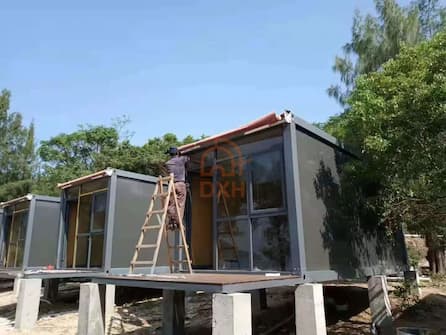Dec 16, 2024
Container houses are increasingly favored by consumers due to their high efficiency, environmental protection, and energy saving. Especially with the increasing number of types and brands of modular container houses in the market, consumers often face some challenges when choosing. How to accurately judge the quality of integrated housing is a problem that every home buyer must face. This article will analyze in detail how to evaluate the quality of integrated housing from multiple dimensions, including materials, structural design, construction technology and safety performance, etc., and compare them with specific parameter tables to help you make an informed choice.
1. Comparison of wall panel materials: heat insulation, fire prevention, waterproofing, durability
The thermal insulation, fire resistance, water resistance and other properties of wall materials directly affect the energy efficiency and safety of integrated houses. More specific test data for common materials are provided here.
Wall panel type
Thermal insulation (λ value)
Fire resistance
Waterproof performance
Durability (service life)
EPS panel
0.035 W/m·K
B1
0.1MPa water pressure resistance
20 years
Rock wool panel
0.038 W/m·K
A1
0.1MPa water pressure resistance
25 years
PU panel
0.022 W/m·K
B2
0.3MPa water pressure resistance
30 years
Interpretation:
λ value (thermal conductivity): The thermal conductivity of the material, the lower the value, the better the thermal insulation.
Fire performance: According to national standards, A1 is a non-combustible material, B1 is a flame-retardant, and B2 is a flammable material.
Waterproofing: Measured by the standard of permeable water pressure, it indicates the maximum water pressure that the wall can withstand.
Durability: Indicates the expected useful life of the material under normal use.
2. Comparison of roofing materials: wind resistance, heat insulation, corrosion resistance, service life
The choice of roofing material directly affects the wind resistance, durability and thermal insulation of the house, especially for houses in windy areas or hot areas.
Type of material
Wind Resistance (Maximum Wind Speed)
Thermal Insulation (Thermal Resistance)
Corrosion Resistance (Salt Spray Test)
Service Life (years)
Tile roof
160 km/h
0.18 m²·K/W
500 hours (in accordance with GB/T 1765)
30 years
EPS roof
180 km/h
0.22 m²·K/W
2000 hours (in accordance with GB/T 8019)
35 years
Interpretation:
Wind resistance: The maximum wind speed that the roofing material can withstand, measured in kilometers per hour (km/h).
Thermal Insulation Effect (Thermal Resistance): The higher the thermal resistance value, the better the thermal insulation performance, in m²· K/W。
Corrosion Resistance: The duration of the salt spray test, measured in hours, to test the durability of a material in a corrosive environment.
Service life: The expected service life of the material according to climate, environment and other factors.
3. Comparison of structure types: wind resistance, seismic resistance, stability, applicable area
The type of structure determines the adaptability of the prefab house in different climatic conditions and environments, especially the ability to resist wind and earthquakes, and it is very important to choose the right structure.
Structure Type
Wind Resistance (Maximum Wind Speed)
Seismic Resistance (Magnitude)
Stability (Maximum Load)
Applicable Area
Light steel structure
200 km/h
8 level
3 kN/m²
Multi-climatic regions
Reinforced concrete structure
150 km/h
9 level
5 kN/m²
High earthquake regions
Timber structure
120 km/h
6 level
2.5 kN/m²
Temperate regions
Interpretation:
Wind resistance: The maximum wind speed that the structure can withstand, measured in kilometers per hour (km/h).
Seismic Capacity: Indicates the maximum earthquake magnitude that the structure can withstand, and the unit is the earthquake magnitude.
Stability (maximum load): The maximum load that the structure can withstand when subjected to external forces such as wind loads and snow loads, in kilonewtons per square meter (kN/m²).
Applicable area: The geographical environment and climatic conditions suitable for the structure type.
4. Comparison of construction technology: connection method, accuracy and waterproof
The construction process directly affects the stability, wind resistance, sealing and service life of the integrated house, and the connection method is the key factor.
Connection
Stability
Construction Efficiency
Waterproof and Windproof Effect
Earthquake Resistance
Bolted connections
High
Medium
Medium
Medium
Welded connections
Very High
Low
Very High
Very High
Pluggable connection
Medium
High
Medium
Low
Interpretation:
Stability: The stability of the connection mode affects the overall wind and earthquake resistance of the house.
Construction efficiency: installation speed, plug-in connections are usually fast, suitable for rapid construction.
Waterproof and windproof effect: The tightness of the connection directly affects the waterproof and windproof effect of the house.
Seismic Resistance: The influence of the connection method on the seismic performance of the house, welded connections provide the best seismic resistance.
5. Safety performance: fire rating, fire resistance time
Fire performance is an important criterion for evaluating the safety of a prefab container house, and the fire rating and fire resistance time are the key to measure the fire protection ability.
Wall Panel Type
Fire Rating
Fire Resistance Time (min)
Rock wool panel
A1
≥ 60 minutes
PU panel
B1
≤ 30 minutes
EPS panel
B2
≤ 30 minutes
Interpretation:
Fire rating: indicates the fire performance of the material, A1 is non-combustible, and B2 is flammable.
Refractory time: Indicates the amount of time that a material is able to maintain a structure at high temperatures, measured in minutes.
Through detailed numerical comparisons, you can more intuitively understand the advantages and disadvantages of different prefab house materials, structures, construction processes and safety performance. When choosing a prefab house, it is recommended that you consider the climatic conditions of your area, the needs of your use and your budget. By referring to the above specific data, you can make more informed and rational decisions to ensure that you buy a high-quality, durable and safe prefab house.
Read More
